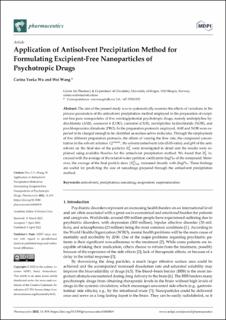Application of Antisolvent Precipitation Method for Formulating Excipient-Free Nanoparticles of Psychotropic Drugs
Journal article, Peer reviewed
Published version

Åpne
Permanent lenke
https://hdl.handle.net/11250/2993627Utgivelsesdato
2022Metadata
Vis full innførselSamlinger
- Department of Chemistry [449]
- Registrations from Cristin [10402]
Sammendrag
The aim of the present study was to systematically examine the effects of variations in the process parameters of the antisolvent precipitation method employed in the preparation of excipient-free pure nanoparticles of five existing/potential psychotropic drugs, namely amitriptyline hydrochloride (AMI), coumarin 6 (COU), curcumin (CUR), nortriptyline hydrochloride (NOR), and prochlorperazine dimaleate (PRO). In the preparation protocols employed, AMI and NOR were expected to be charged enough to be identified as surface-active molecules. Through the employment of five different preparation protocols, the effects of varying the flow rate, the compound concentration in the solvent solution Csolvent0, the solvent:antisolvent ratio (SAS-ratio), and pH of the antisolvent on the final size of the particles DfH were investigated in detail and the results were explained using available theories for the antisolvent precipitation method. We found that DfH increased with the average of the octanol-water partition coefficients (logP)av of the compound. Moreover, the average of the final particle sizes (DfH)av increased linearly with (logP)av. These findings are useful for predicting the size of nanodrugs prepared through the antisolvent precipitation method.
